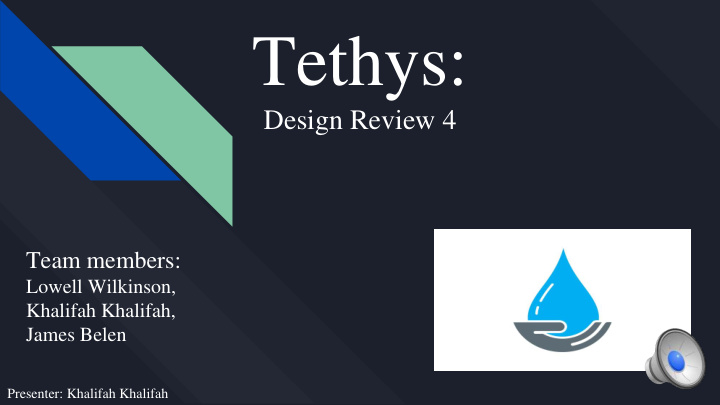



Tethys: Design Review 4 Team members: Lowell Wilkinson, Khalifah Khalifah, James Belen Presenter: Khalifah Khalifah
A Short Project Refresher ● Our client, Dr. Kimberly Samuels-Crow, is studying the process of water moving through the atmosphere. ● She has an instrument that makes real-time measurements of the isotopic composition of water vapor to accomplish her research. ● Our project is to design and install an automated valve for her instrument that will allow her to remotely control and analyze her readings. Presenter: Khalifah Khalifah
Project Motivation ● Our client intends to take measurements at different elevations within a certain ecosystem. ● She uses her measurements to categorize whether the vapor entered the atmosphere via evaporation or transpiration. ● Different measurements require manual adjustment of what is being passed into the inlet of her instrument. ● Our client needs us to automate this manual adjustment to improve her efficiency in the field. Presenter: Khalifah Khalifah
Project Approach • GUI remote • Automated – can read a text file for settings off a ● To understand our SD card or similar constraints, we spoke with • Power from marine DC batteries our client and established a • Switch between three or more gas / tube sources • Record exactly when the switch happens list of requirements. • Characterize what the switch looks like, and how ● We also brainstormed as a long the instrument memory is team to generate further • Characterize minimum signal duration for noise free measurements contributions. • MATLAB functions for data cutting ● To the right, you can see • Manual override most of our requirements • Weatherproof • Quick set up for this project. • Remotely updatable settings for timing • DIY instructions for the isotope community – must utilize a high number of “off the shelf ” components (ie: Arduino, Teensy, or Rasp. Pi) Presenter: Lowell Wilkinson
Subsystem Breakdown ● We broke our project down into three subsystems. These were easy to decide as there were three clear sections to be completed in this project. ● There is an electronic valve subsystem that is comprised of the electronic valve, the relay, and the microcontroller. Lowell took responsibility for this system. ● There is a communication system that included a remote desktop application on our client’s instrument as well as the Arduino IDE that ran our control program. This was under James’s responsibility. ● There is also a power subsystem that included a generator, a fuel tank, and a UPS. Khalifah took responsibility for that system. Presenter: James Belen
Prototypes Early on, we were not able to prototype very efficiently. We did not have our electronic valve shipped to us yet so we could not set up the electronic valve subsystem prototype. We did not have a generator either, so no power subsystem prototype either. However, we were able to prototype the Arduino control circuit and the communication system. We set up a remote desktop using two computers to prototype the Arduino controller, which was successful, but that didn’t help us make much progress. Once our parts came in, we went straight into production of the final product. Presenter: James Belen
Electronic Valve Subsystem • This subsystem was completed successfully. • The valve immediately changes to the client’s desired position when ordered to. • Our client needed only to compile the supplied Arduino code and attach the valve to her instrument to be ready for field tests. Presenter: Lowell Wilkinson
Commmunication Subsystem This was the one of the two ● subsystems we were able to prototype The device communication is ● also the first subsystem to be fully complete Client’s analyzer instrument ● acts as a desktop to provide valve control and real-time output An external Wi-Fi adapter ● was required for wireless communication Presenter: James Belen
Subsystem #3: Power System Presenter: Khalifah Khalifah
Challenges Our first Challenge was when our original electronic valve ● was swapped for another valve with a different power supply. Our second challenge involved a miscommunication in ● purchasing supplies which delayed us two weeks. Another challenge was securing an on-campus workspace. ● Another challenge was using the gas generator. ● The last challenge was our rushed construction and delivery of ● our product to our client. Presenter: Khalifah Khalifah
Final Product This is the only video that we have of our project. Due to the virus, we are unable to get a better representation for this presentation. However, the final product was delivered to our client. Presenter: Lowell Wilkinson
Future Work Future work may include the following: Manual Override Straps to secure instruments Updated UI Wireless field connection More inlets for the valve Presenter: Lowell Wilkinson
Conclusion • Design, create, and implement an automatic real-time instrument to aid the measurement and analysis of water vapor • The automatic valve system must be able to switch between inlets of different elevations, contain self-generating power source, a user interface and communication system that can allow remote control of the instrument • Power System will power all components of the instrument and auxiliary accessories • communication system will be responsible for displaying analyzer output as well as provide remote control for the electronic valve • We achieved our client requirements and we delivered our product to the client Presenter: Khalifah Khalifah
Recommend
More recommend